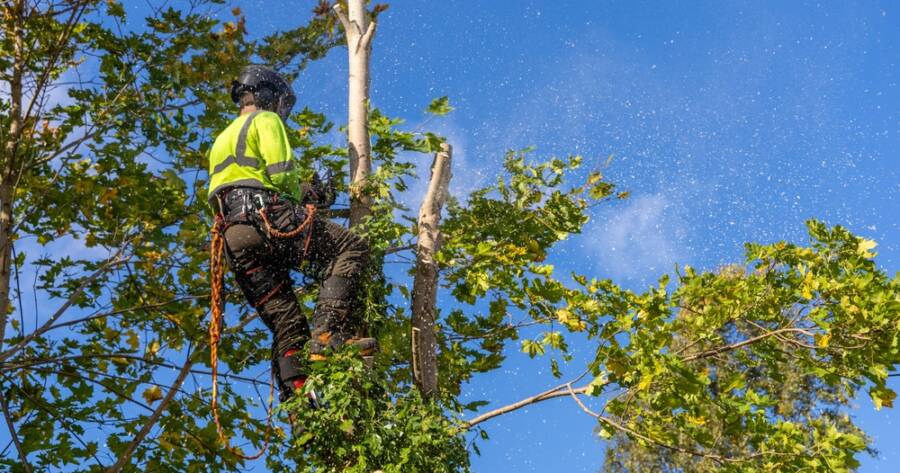Tree removal is a task many homeowners eventually face, whether it’s due to storm damage, disease, structural instability, or to make room for landscaping and construction projects. While trees add beauty, shade, and value to a property, a dead, diseased, or dangerously leaning tree can pose serious safety risks to people, structures, and surrounding landscapes.
When Tree Removal Might Be Necessary
Tree removal may become necessary for a variety of reasons. You might need to remove a tree if:
- The tree is dead or dying: A dead tree can become unstable over time, posing a danger to nearby structures, vehicles, or people.
- The tree is diseased: Trees affected by disease can sometimes be treated, but in severe cases, removal might be the best option to prevent the spread of disease to other trees.
- It’s damaged by storms: Trees weakened or broken by strong winds, ice, or lightning may become dangerous and need removal.
- The tree is too close to a structure: Overgrown roots or branches can interfere with buildings, foundations, or power lines, making removal necessary to avoid costly repairs or damage.
- Landscaping or construction plans require it: You may need to remove a tree to clear space for new construction or landscaping.
Once you’ve determined that tree removal is necessary, you have a few options to consider.
Tree Removal Options
- Professional Tree Removal Services: Hiring a professional tree removal service is the safest and most effective way to remove a tree. Arborists or tree removal experts have the experience, tools, and knowledge to remove trees safely, even in tricky locations such as near buildings or power lines. They can also handle stump removal and cleanup afterward. This option is ideal for large trees, trees in hazardous locations, or when you need the job done quickly and efficiently.
- DIY Tree Removal: For smaller trees or shrubs, you might consider removing the tree yourself. However, it’s important to recognize that tree removal can be dangerous, especially if you lack the proper tools or experience. If the tree is near power lines, buildings, or other valuable property, it’s best to leave the job to professionals. DIY tree removal can save money, but the potential risks should be carefully weighed before deciding.
- Partial Tree Removal (Pruning or Trimming): In some cases, a tree doesn’t need to be fully removed. If a tree is healthy but has overgrown branches, you might only need trimming or pruning to reduce its size or remove potentially hazardous limbs. This option can preserve the tree while addressing immediate safety concerns.
- Stump Removal or Grinding: After a tree is cut down, you’re often left with a stump that can be unsightly and take up valuable yard space. Stump removal involves digging up the entire stump and root system, while stump grinding reduces the stump to ground level. Many tree removal services offer stump grinding as part of the package, or you can hire a separate service for stump removal later. Leaving the stump may lead to future issues like pests or regrowth, so it’s important to consider whether you want it removed entirely.
Tree Removal Costs: What to Expect
Tree removal costs can vary widely depending on several key factors, including the tree’s height, species, condition, location on your property, and whether additional services (like stump grinding or debris removal) are required. Understanding the price range helps homeowners budget more accurately and avoid surprise fees.
Average Tree Removal Costs by Size
-
Small Trees (under 30 feet): $150 – $500
-
Medium Trees (30–60 feet): $500 – $1,000
-
Large Trees (over 60 feet): $1,000 – $2,000+
-
Additional Costs (stump grinding, branch removal, emergency service): $75 – $300+
Factors Affecting Tree Removal Costs
Several factors could influence the cost of removing a tree, including:
- Tree size: Larger trees require more labor, time, and equipment to remove, which will increase the overall cost.
- Tree location: If a tree is near a building, power lines, or other structures, the complexity of the removal increases, as special care must be taken to avoid damage.
- Tree condition: Dead or damaged trees can be more dangerous to remove, particularly if they’re unstable. This can raise the cost of the removal process.
- Additional services: If you want the stump removed, the tree cut into firewood, or debris cleaned up, these services may add to the total cost.
- Local regulations: In some areas, permits are required for tree removal, especially for trees above a certain size or in protected areas. These permits can affect both the timeline and the cost of removal.
Weighing Your Options
When considering tree removal, it’s important to evaluate your specific situation, including the size and location of the tree, any potential hazards, and whether you’re prepared to handle the job yourself or hire professionals. While DIY removal might be feasible for smaller trees, professional tree removal services are usually the safest and most efficient option for large or hazardous trees. By weighing these factors, you can make an informed decision about the best approach to tree removal for your home.

